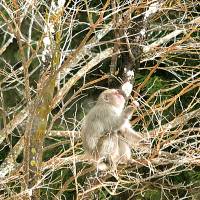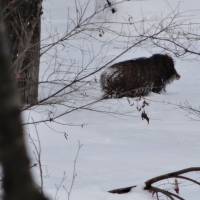When I came to live in Kurohime in northern Nagano Prefecture in the late autumn of 1980, I was a bit awed by the amount of snow, which piles up and compacts to a depth of 5 meters in the mountains.
For the first year, we rented an old thatched house, which looked great in photographs — but living there meant more snow-shoveling in one winter than during all the Arctic expeditions I've been on. We'd get a meter of the white stuff overnight, and every couple of days it had to be shoveled off the roof. This task took two full days, and I had to do it 12 times that winter — and that was just the roof.
In the autumn of 1981, I got a Japanese gun license and a hunting license and joined the local Hunters Association. My reason for this wasn't primarily to kill animals and birds (although I didn't mind the occasional hare, duck or pheasant as long as they were plentiful), but because I wanted to learn about the mountains, forests and wildlife — and as far as I'm concerned, local hunters are a very good source of such information, including folklore and legend.
At that time there were no wild boar, deer or macaques in our area, although all three were fairly common in more southerly regions of Nagano. Of course, the hot-spring-loving macaques, widely known as "snow monkeys," are a popular tourist attraction in Jigoku Dani ("Hell Valley"), an hour's drive from Kurohime. And as far as the local hunters were concerned, it was just fine that they were over yonder — and not here.
Japanese macaques (Macaca fuscata) have been the subject of many studies, partly because they learn things, such as washing food, for example, and pass the knowledge on. They are gregarious, living in bands of up to a couple of dozen led by a cunning and experienced male who will scout out the land ahead, often climbing trees to get a better look. His cries will either warn the others off, or tell them whether or not it is safe to advance into a cornfield, orchard or whatever.
Macaques do tremendous damage to agriculture and gardens, and those that have become used to humans will steal from people's bags, from cars left with windows open, from shops with open fronts — or anywhere else that takes their fancy.
On Yakushima Island, Kagoshima Prefecture, I heard tales of single male monkeys entering houses, especially in the summer when upper windows were left open, and eating the sweet-bean cakes traditionally left on the table for visitors. One old lady even told me, "Soon that monkey will be expecting me to serve it tea."
Laughs aside, though, macaques can be very aggressive, especially males.
Generally speaking, Japanese hunters are reluctant to shoot these monkeys, even when asked to do so, because they look too much like humans. My old forester Mr. Matsuki, now retired, told me that monkey meat used to be considered as medicine, although I have not met any other Japanese people who would be willing to try it. Me? No thank you!
Up until about 15 years ago, we never saw deer, wild boar or monkeys in our area, and I was led to believe that was due to the depth of snow over the winters. However, whether or not it's due to climate change, both deer and wild boar have come into our area.
Previously, I have made a couple of television documentaries about deer in other parts of Japan, and we have filmed them stripping twigs and tree trunks in the winter, as well as ones that succumbed to starvation. Now, though, we're getting them in our Afan Woodland Trust woods, but so far only young stags.
It is a common trait with deer for the young stags, who have been driven away from the females, to venture into new areas — sometimes even by swimming to islands. If the area is suitable, does will then follow later and the deer numbers will obviously increase.
Since we began thinning out the dense cedars from the national forest adjoining our Afan woods two years ago, more than 30 new species of plants have grown up because of the light now reaching the ground, and no doubt several of these could become deer fodder. We'll just keep monitoring.
Wild boar, on the other hand, have become very common in this area. Last year, nearly all my potatoes were eaten by them, and they regularly root up the woodchip pathways we've laid in our woods to get at earthworms and other tasty tidbits.
Mr. Matsuki and my next-door neighbor have both been trapping and killing wild boar — males, females and young — and the boar, as well as deer and other animals, often get snapped by the motion-sensitive cameras we set around our woodlands.
Five years ago we had boars overwinter in the woods, using the cover of the scattered patches of tall bamboo grass that get bent over by the early snows, making spaces below that can become their winter dens. Recently, too, our current forester, Atsushi Ishii, managed to photograph a wild boar charging through the snow like a little snowplow.
There are also some very muddy places fed by springs that never freeze up, and these have become year-round wild boar wallows.
Regarding monkeys, however, although we have found what we believe to be their droppings, so far we haven't seen any of the actual animals. Nonetheless, there have been several sightings of them on the other side of nearby Mount Kurohime, which faces Mount Myoko in Niigata Prefecture, and in the middle of March this year, my photographer friend, Kenji Minami, got several shots of a single male macaque in a tree close to his house, which is by the Mount Kurohime ski slopes.
Probably it was the same male that stole pumpkins from Mr. Matsuki's home garden — prompting him to intone most solemnly when I saw him afterward: "They're coming. Without a doubt, they're coming."
If that lone male does bring in a band of macaques, we can say goodbye to any hopes of growing shiitake mushrooms. These Japanese monkeys pick shiitake from the logs and munch on the stems, usually throwing the caps away. All in all, they are very wasteful eaters. However, our woods have been declared a protected area, so there isn't much we can do about it.
Meanwhile, it is now 30 years since I began buying parcels of adjoining woodland and bringing the whole area back to life, and we have seen many changes, most of them good. Sadly, though, since towers were erected to extend and improve cellphone reception, we have seen a drastic decline in the number of small woodland birds. As to whether the two are connected, time will tell. Certainly there has been no noticeable change in natural predators, and certainly no pesticides of any kind have been used in the woods, and very little used on adjoining land either.
I've noted a similar decline in the patch of woodland at the back of my house. It used to be a delight to sit having a meal or sipping tea with honey, looking out of the big picture window to watch various kinds of tits, woodpeckers, sparrows, narcissus flycatchers, nuthatches, white-eyes and others. Up until six years ago there used to be dozens of them, now they are getting scarce.
Looking up this topic on the Internet convinces me that my suspicions about the effects of cellphone towers on birds are well founded — which depresses me no end. We have put so much effort into changing our own 31 hectares of woodland to make it attractive to birds, and until those towers went up we had close to 100 species, with lots and lots of migrant visitors.
I don't use a cellphone myself, but looking at all the people on trains, or walking around the cities with their faces stuck into them and oblivious to everything else, tells me how ubiquitous they have become. So even if a link between the towers and disappearing birds is established, the phone companies will never admit to being the cause of such a loss in wildlife — and neither they nor the public will want to do anything about it either.
If I were able to pick neighbors, I would far prefer birds to macaques — or those damnable towers — but alas, the choice is not mine.




